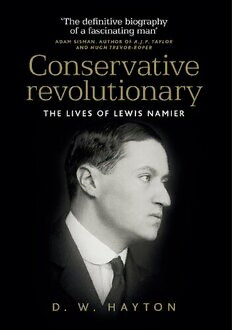
Conservative Revolutionary: The Lives of Lewis Namier PDF
Preview Conservative Revolutionary: The Lives of Lewis Namier
Conservative revolutionary Conservative revolutionary The lives of Lewis Namier D. W. Hayton Manchester University Press Copyright © D. W. Hayton 2019 The right of D. W. Hayton to be identified as the author of this work has been asserted by him in accordance with the Copyright, Designs and Patents Act 1988. Published by Manchester University Press Altrincham Street, Manchester M1 7JA www.manchesteruniversitypress.co.uk British Library Cataloguing- in- Publication Data A catalogue record for this book is available from the British Library ISBN 978 0 7190 8603 8 hardback First published 2019 The publisher has no responsibility for the persistence or accuracy of URLs for any external or third- party internet websites referred to in this book, and does not guarantee that any content on such websites is, or will remain, accurate or appropriate. Typeset by Servis Filmsetting Ltd, Stockport, Cheshire In memory of Keith John Jeffery (1952–2016) and John David Milner (1949–2016) v ‘Listen, Kolya, among other things, you are going to be very unhappy in life,’ Alyosha said … ‘But even so, life on the whole you will bless.’ Dostoyevsky, The Brothers Karamazov A man’s fairest memorial is still his own portrait. Goethe Contents List of illustrations viii Acknowledgements ix Abbreviations xiv Prologue: in search of Namier 1 1 Avenues of history: the child and the man, 1888–1913 12 2 Personalities and powers, 1913–17 55 3 Facing east, 1917–20 88 4 In the margin of history, 1920–28 132 5 Skyscrapers, 1928–32 170 6 Europe in decay, 1932–38 209 7 In the Nazi era, 1938–47 252 8 Crossroads of power, 1947–56 308 9 Conflicts, 1956–60 350 10 Vanished supremacies 391 Bibliography 418 Index 435 vii Illustrations 1 The Bernstein family, c.1893 16 2 Koszylowce, at the funeral of Tadeusz Modzelewski, 1936 (courtesy of Jarosław Kurski) 17 3 Lewis Namier, 1915, © George C. Beresford/Hulton Deutsch Collection/ Getty Images 60 4 A. L. Smith 61 5 Blanche Dugdale (‘Baffy’) 214 6 Chaim Weizmann and David Ben- Gurion 215 7 Clara Namier 258 8 Julia, Lady Namier 259 9 Lewis Namier, 1947, by Walter Stoneman © National Portrait Gallery 356 10 Receiving a DCL at Oxford, June 1955, Namier in procession alongside Dame Ninette de Valois © Ron Case/Keystone/Hulton Archive/ Getty Images 357 viii Acknowledgements I conceived the idea for this biography nearly twenty years ago while working through the archives of the History of Parliament Trust. I was engaged in writing the ‘Introductory Survey’ for the section of the History covering The House of Commons 1690–1715 and was anxious to discover what the founding fathers envisaged as the purpose of the project, so that I could set my work along appropriate lines. What I found was a long and complicated story, at the root of which was the simple answer that there was no clear and agreed purpose. But in ploughing through the papers in the basement of the Trust’s offices in Bloomsbury Square I came upon a treasure- trove of material relating to Namier, boxes of letters which had never been studied by anyone interested in his life and work. Since then I have examined scores of other manuscript collections, but have repeatedly returned to the History’s archive. It is only appropriate, therefore, that I begin this prolonged litany of thanks with an acknowledgment of the debt I owe to the History of Parliament Trust, its trustees and editorial board, and its current director, Dr Paul Seaward, not only for facilitating my research, but also for bearing with the publication of findings which may not always have been flattering to the public image of the History. I owe an even greater debt to a previous editorial board, chaired by Dr Edward Miller, and including two close associates of Namier, Professor Ian Christie and Dame Lucy Sutherland, for giving me my first job, over forty years ago, and to Eddie Mullins, Paul Seaward’s ultimate predecessor, for initiating me into what was in 1975 a decid- edly peculiar organisation within the academic world. The shade of Namier presided over 34 Tavistock Square, where the History was then located, and a number of those with whom I worked had known Namier personally, some of them very well. Eveline Cruickshanks, who served as a research assistant on the section immediately preceding Namier’s, has allowed me to interview her formally, as have three of Namier’s surviv- ing research students, Alan Hardy, Jean Spendlove and Peter Thomas, one of his last undergraduate pupils, Kenneth Hardman, and Stanley Katz, for whom Namier stood ix
